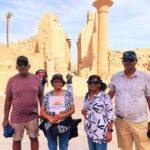The Valley of the Queens Egypt is a treasure trove of history, art, and culture that often gets overshadowed by the more famous
Valley of the Kings Egypt. This ancient burial ground is home to the tombs of queens, royal children, and other significant figures from the New Kingdom period.
In this blog post, we will explore some intriguing facts about the Valley of the Queens, shedding light on its historical importance and cultural significance.
Whether you’re planning a visit or just looking to expand your knowledge, this guide offers a comprehensive overview of this remarkable site.
What Is the Valley of the Queens Egypt?
The Valley of the Queens Egypt is located on the west bank of the Nile River, near Luxor, and ancient Egyptians primarily used it during the 18th to 20th dynasties.
While the Valley of the Kings served as the burial place for pharaohs, the Valley of the Queens was designated for their wives, royal mothers,
and other important women of the time. The ancient Egyptians believed that the afterlife continued life on earth, so they buried the
queens with everything they would need in the next world.
The Valley of the Queens Egypt Facts You Should Know
1. Origins and Naming
The Valley of the Queens Egypt , known as Ta-Set-Neferu in ancient Egyptian, translates to “the place of the queens.” This name reflects the valley’s purpose as the
final resting place for queens and royal women. It was established around 1550 BCE during the reign of the 18th dynasty and continued to be used until the end of the 20th dynasty.
2. Number of Tombs
The Valley of the Queens Egypt contains over 90 tombs, with some of the most notable belonging to the wives of pharaohs and their children.
The tombs range from small, simple burial sites to grand, elaborately decorated chambers. Each tomb provides insights into the artistic styles
and burial practices of ancient Egypt.
3. Famous Tombs
Among the most significant tombs in the Valley of the Queens Egypt are:
- Tomb of Nefertari (QV66): This tomb is renowned for its breathtaking wall paintings and vibrant colors. Nefertari was the wife of Ramses II,
- and her tomb is considered one of the most beautifully decorated in all of Egypt. Visitors often describe the experience of seeing the tomb as awe-inspiring, with its depiction of Nefertari as a goddess in the afterlife, surrounded by lush gardens and beautiful landscapes.
- Tomb of Amenherkhepshef (QV55): The tomb of this prince, son of Ramses II, features intricate carvings and inscriptions that tell the story of his life and aspirations. The tomb’s artistry reflects the importance placed on legacy in ancient Egyptian culture, emphasizing the connection between life and the afterlife.
- Tomb of the Two Ladies (QV49): This unique tomb is believed to be the final resting place of two queens, possibly related to Pharaoh Merenptah. The layout and decorations within the tomb provide insights into the customs and traditions surrounding royal burials.
4. Artistic Significance
The artwork found in the Valley of the Queens Egypt is a significant aspect of its historical importance. The tombs are adorned with stunning frescoes,
hieroglyphics, and carvings that depict scenes from the afterlife, religious rituals, and daily life. These artistic masterpieces offer invaluable insights into the beliefs,
customs, and lifestyle of ancient Egyptians. The vibrant colors and detailed depictions are a testament to the skill and creativity of the ancient artists.
5. Role of Queens in Ancient Egypt
The queens in ancient Egypt wielded substantial power and influence. They did not simply serve as the wives of pharaohs; many actively participated in
political affairs, served as regents, and earned recognition as goddesses on earth. The tombs reflect their high status and the important roles they played in society.
Royal marriages often functioned as political alliances, aimed at consolidating power and ensuring the kingdom’s stability.
For instance, Queen Hatshepsut, one of the most famous female pharaohs, defied gender norms and ruled as a king. People celebrate her reign for significant architectural achievements and successful trade expeditions.
The legacy of such powerful women resonates in the Valley of the Queens Egypt, where their stories continue to unfold through the walls of their tombs.
6. Burial Practices
The burial practices in the Valley of the Queens Egypt mirror those found in the Valley of the Kings. Each tomb was designed to
ensure the deceased’s safe passage into the afterlife, complete with essential items such as furniture, jewelry, and food. These practices
highlight the Egyptians’ beliefs in the afterlife and their desire for immortality. Funerary items included shabtis (figurines meant to serve the deceased in the afterlife),
amulets for protection, and beautifully crafted artifacts that reflected the individual’s status.
7. Cultural and Historical Impact
The Valley of the Queens is crucial for understanding the social structure of ancient Egypt. It reveals the significance of women in society and their contributions
to politics and religion. The tombs serve as a testament to the queens’ legacy and their impact on Egyptian history. Many of the tombs also include inscriptions that reflect the
queens’ virtues, such as motherhood, loyalty, and wisdom, emphasizing the values cherished in ancient Egyptian culture.
8. Visiting the Valley of the Queens Egypt
The Valley of the Queens Egypt is less crowded than the nearby Valley of the Kings, providing a more intimate experience for visitors.
Exploring the tombs allows for a deeper appreciation of the artistry and craftsmanship of ancient Egyptian artisans. To make the most of your visit:
- Plan Ahead: Arrive early to avoid crowds and have ample time to explore the site. Consider visiting during the cooler months, as Luxor can be quite hot in summer.
- Hire a Guide: A knowledgeable guide can provide insights and stories about the tombs, enhancing your experience. They can also help you navigate the site and understand the significance of what you’re seeing.
- Respect the Site: Always be mindful of the preservation efforts in place. Avoid touching the walls or taking flash photographs. Respect the silence and sanctity of this historical site, as it allows others to experience its beauty.
9. Nearby Attractions
The Valley of the Queens is located near other significant archaeological sites, including the Valley of the Kings and the Temple of Hatshepsut.
Consider combining your visit to make the most of your time in Luxor. Each site offers a unique perspective on the rich history of ancient Egypt.
The Temple of Hatshepsut, built into the cliffs, is an architectural marvel that tells the story of one of Egypt’s most remarkable female rulers.
10. Events and Exhibitions
As interest in ancient Egyptian history continues to grow, the Valley of the Queens occasionally hosts events and exhibitions.
These events provide deeper insights into the archaeological discoveries made in the area and the ongoing efforts to preserve this vital part of Egypt’s heritage.
Keep an eye on local tourism websites or visitor centers for information on upcoming events.
11. Local Culture and Heritage
Visiting the Valley of the Queens also offers an opportunity to engage with the local culture. Luxor is known for its vibrant markets, delicious cuisine,
and warm hospitality. Take the time to explore the local area, try traditional Egyptian dishes, and interact with the residents. This cultural exchange
enriches your experience and creates lasting memories of your journey.
Conclusion: The Lasting Legacy of the Valley of the Queens Egypt
The Valley of the Queens Egypt is a captivating site that offers a glimpse into the lives of powerful women in ancient Egypt. The tombs, adorned
with intricate artwork and rich history, tell the stories of queens and royal figures whose legacies continue to resonate today. As you explore this fascinating site,
you’ll gain a deeper appreciation for the artistry, culture, and beliefs that shaped one of the world’s oldest civilizations.
Visiting the Valley of the Queens is more than just a historical exploration; it’s an opportunity to connect with the past and honor the remarkable women
who played a pivotal role in shaping ancient Egypt. Whether you’re an avid historian or a curious traveler, this enchanting valley promises an unforgettable
experience filled with wonder and discovery.
The Valley of the Queens stands as a testament to the strength, beauty, and significance of women in a civilization that has fascinated people for centuries.
As we continue to uncover more about this remarkable site, it serves as a reminder of the legacies left behind and the stories still waiting to be told.





